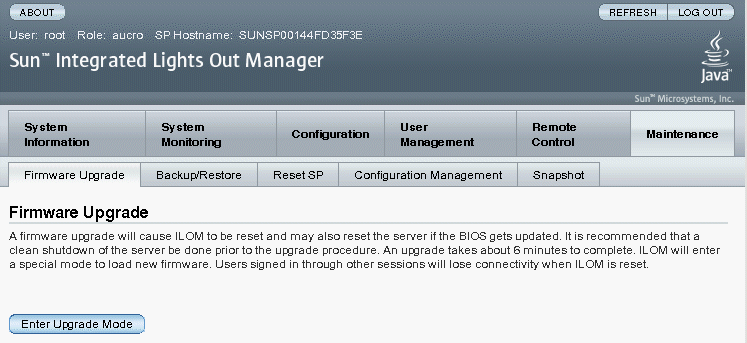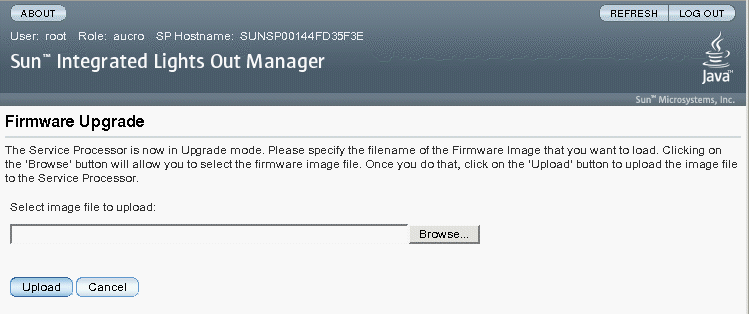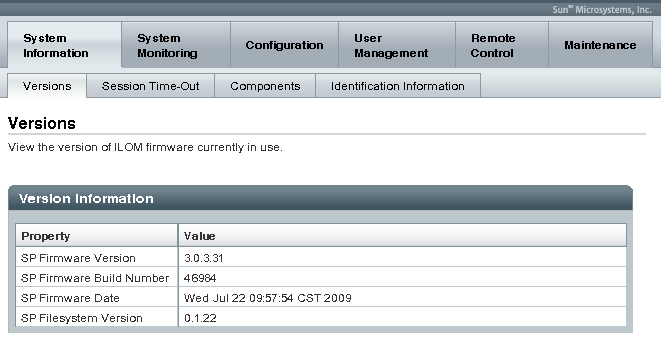| Skip Navigation Links | |
| Exit Print View | |

|
Sun Fire X4640 Server Product Documentation Sun Fire X4640 Server Documentation Library |
| Skip Navigation Links | |
| Exit Print View | |

|
Sun Fire X4640 Server Product Documentation Sun Fire X4640 Server Documentation Library |
Get Software and Firmware Downloads
About This Documentation (PDF and HTML)
Hardware Installation and Product Notes
Sun Fire X4640 Server Front and Back Panel Features and Components
Installing the Server Hardware
Removing the Server From the Rack
Getting Service for Your Server
Sun Fire X4640 Server Specifications
Communicating With the ILOM and the System Console
Setting Up Your Operating System
Overview of the Sun Fire X4640 Server Product Notes
Supported Software and Firmware
Solaris Operating System Issues
Windows Operating System Issues
VMware ESX and VMware ESXi Issues
Sun Installation Assistant Issues
MegaRAID Storage Manager (MSM) Issues
Integrated Lights Out Manager (ILOM) Issues
Introduction to Sun Installation Assistant
Getting Started With Sun Installation Assistant
Starting SIA and Preparing for Deployment or Recovery Tasks
Using SIA to Upgrade System Firmware
Using SIA to Recover a Service Processor
Performing an SIA PXE-Based Attended Installation
Performing an SIA PXE-Based Unattended Installation
Observing an SIA PXE-Based Unattended Installation
Creating a Bootable SIA USB Flash Drive
Identifying a Linux Boot Device on a Sun Fire X4500 Server
Introduction to Solaris OS and OpenSolaris Installation
Installing the Solaris 10 Operating System
Installing the OpenSolaris Operating System
Booting From OS Distribution Media
Identifying Logical and Physical Network Interface Names for Solaris OS Installation
Preliminary Tasks Before Installing An OS
Introduction to Linux Installation
Sun Installation Assistant (SIA)
Installing Red Hat Enterprise Linux
Installing and Updating SUSE Linux Enterprise Server
Configuring a Linux Server to Support PXE Installation
Booting From OS Distribution Media
Preliminary Tasks Before Installing An OS
Identifying Logical and Physical Network Interface Names for Linux OS Configuration
Introduction to Windows Installation
Sun Installation Assistant (SIA)
Getting Started With Windows Server 2008 Installation
Selecting a Media Delivery Method
Installing Windows Server 2008
Updating Critical Drivers and Installing Supplemental Software
Incorporating Sun Fire Drivers Into a WIM Image
Identifying Network Interfaces in Windows
Introduction to ESX Installation
Installing VMware ESXi 4.0 Installable
Booting From OS Distribution Media
Preliminary Tasks Before Installing An OS
Administration, Diagnostics, and Service
Overview of the ILOM Supplement
Communicating With the ILOM and the System Console
About ILOM SP IP Addresses and the ILOM Interfaces
How to Get the SP IP Address Using the BIOS Setup Utility
How to Get the SP IP Address By Using a Serial Connection and the CLI
How to Connect to the Command-Line Interface Using SSH
How to Connect to the ILOM Command-Line Interface Through the Serial Management Port
How to Connect to the ILOM Web Interface
Connecting to the System Console
How to Connect to the Server Locally (Physical Console)
How to Connect Remotely Using the ILOM Web Interface
How to Connect to the Serial Console Using the ILOM Command-Line Interface
Determining Current Firmware Versions
How to Verify the ILOM and BIOS Firmware Versions Using the Web Interface
How to Verify the LSI HBA Firmware Version
Preparing for the Firmware Update
How to Plan the Firmware Update
How to Download Firmware Updates
Updating the ILOM and System BIOS
How to Update the ILOM and System BIOS Using the Command-Line Interface
Updating the Embedded HBA BIOS
How to Update the LSI Firmware Using the Remote Console Method
How to Update the LSI Firmware Using the Local Method
Using ILOM to Monitor the Host
Overview of the Diagnostics Guide
Introduction to System Diagnostics
Using the ILOM to Monitor the Host
Using SunVTS Diagnostics Software
Creating a Data Collector Snapshot
Sun Fire X4640 Server Service Manual Overview
Controlling Power and Performing Hardware Reset
Removing and Installing Components
Configuring the System Using the BIOS Setup Utilities
Before You Begin
Identify the version of ILOM that is currently running on your system. See Determining Current Firmware Versions.
Download the firmware image for your server or CMM from the Sun platform's product web site. See How to Download Firmware Updates.
Copy the firmware image to the system on which the web browser is running, using a supported protocol (TFTP, FTP, HTTP, HTTPS).
Obtain an ILOM user name and password that has Admin (a) role account privileges. You must have Admin (a) privileges to update the firmware on the system.
Note - The firmware update process takes about six minutes to complete. During this time, do not perform other ILOM tasks. When the firmware update is complete, the system will reboot.
The Firmware Upgrade page appears.

An Upgrade Verification dialog appears, indicating that other users who are logged in will lose their session when the update process is completed.
You are prompted to select an image file to upload.

Wait for the file to upload and validate.
The Firmware Verification page appears.
When you click Start Upgrade the upload process starts and a prompt to continue the process appears.
Note - If you did not preserve the ILOM configuration before the firmware update, you need to perform the initial ILOM setup procedures to reconnect to ILOM.
The Update Status page appears, providing details about the update progress. When the update indicates 100%, the firmware upload is complete. When the upload is completed, the system automatically reboots.
Note - The ILOM web interface might not refresh properly after the update is completed. If the ILOM web interface is missing information or displays an error message, you might be viewing a cached version of the page from the version previous to the update. Clear your browser cache and refresh your browser before continuing.
